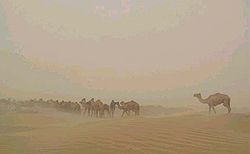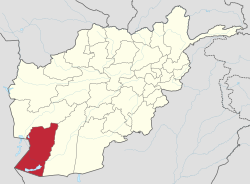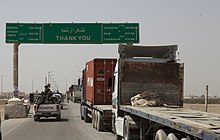Nimruz Province

Nimruz ولایت نیمروز د نیمروز ولایت نیمروچ ولایت | |
|---|---|
 Chakhansur in Nimruz Province | |
 Map of Afghanistan with Nimruz highlighted | |
| Coordinates (Capital): 31°00′N 62°30′E / 31.0°N 62.5°E | |
| Country | |
| Capital | Zaranj |
| Government | |
| • Governor | Najibullah Rafi[1] |
| • Deputy Governor | Ghulam Nabi "Osmani"[2] |
| • Police Chief | Sardar Mohammad Ayoubi |
| Area | |
| • Total | 43,000 km2 (17,000 sq mi) |
| Population (2021)[5] | |
| • Total | 186,963 |
| • Density | 4.3/km2 (11/sq mi) |
| Time zone | UTC+4:30 (Afghanistan Time) |
| Postal code | 43xx |
| ISO 3166 code | AF-NIM |
| Main languages Pashto | Balochi Dari [4] |
Nimruz or Nimroz (Balochi: نݔمرۏچ; Dari, Pashto: نیمروز) is one of the 34 provinces of Afghanistan, located in the southwestern part of the country. It lies to the east of the Sistan and Baluchestan Province of Iran and north of Balochistan, Pakistan, also bordering the Afghan provinces of Farah and Helmand. It has a population of about 186,963 people.[5] The province is divided into five districts, encompassing about 649 villages.
The city of Zaranj serves as the provincial capital and Zaranj Airport, which is located in that city, serves as a domestic airport for the province. The recently-built Kamal Khan Dam is located in Chahar Burjak District.
The name Nimruz means "mid-day" or "half-day" in Persian Language and Balochi. The name is believed to indicate that the meridian cutting the old world in half passes through this region. Nimruz covers 43,000 km2.[4] It is the most sparsely populated province in the country,[6] located in the Sistan Basin. A substantial part of the province is the barren desert area of Dasht-e Margo.
In 2021, the Taliban gained control of the province during the 2021 Taliban offensive.
History
[edit]The name Zaranj was derived from Persian word "Zranka" and is considered to be one of the oldest cities in Nimruz Province Top Tourist Places to Visit in Zaranj, Nimruz, Afghanistan. The area now composing Nimruz province of Afghanistan was once part of the historical region of Sistan, which over the many centuries was held by the Achaemenid Empire, Alexander the Great and others before being conquered and converted to Islam by the Muslim Arabs in the seventh century. The region became part of the Saffarid dynasty in 860 CE with its capital at Zaranj, which was one of the first local dynasties of the Islamic era. Its founder Yaqub Saffari was born and raised in this region. The territory became part of the Ghaznavids followed by the Ghurids, Timurids, and Safavids.
In the early 18th century, the region fell to the Afghan Hotaki dynasty until they were removed from power in 1738 by Nader Shah. By 1747, Ahmad Shah Durrani made it part of Afghanistan after he conquered the territory from northeastern Iran to Delhi in India. Under the modern Afghan government, the province was known as Chakhansur Province until 1968, when it was separated to form the provinces of Nimruz and Farah.[7] The city of Zaranj became the capital of Nimroz province at that time. During the Soviet–Afghan War, Nimruz province was used by mujahideen crossing back and forth between Afghanistan and neighboring countries. It was also used by Afghan refugees escaping the war as well as by smugglers.
As the Taliban came to power in 1995, they seized the road-controlling town of Delaram (now within Farah Province), and came to an agreement with local mujahideen commanders that the fate of the province would not be decided until a clear victor emerged in the capture of Kabul. However, the Taliban advanced on Nimruz only days later, and the mujahideen under command of Abdul Karim Brahui fled to Iran.[citation needed]
21st century
[edit]2000s
[edit]
Following the US-led invasion in October 2001, the Taliban began losing control of the province to the new Afghan government under President Hamid Karzai.[8] The area is historically known for drugs and weapons smuggling between Afghanistan, Iran and Pakistan. Many foreign militants also use the province to go back and forth between the 3 nations. The Delaram–Zaranj Highway was built by the Indian government in 2009, which is one of the main trade routes in the country and is expected to boost the socio-economic development in the province.
Since 2002, members of the U.S. Marine Corps were present in the province. When the International Security Assistance Force (ISAF) arrived at Kandahar, Nimruz province became part of the Regional Command Southwest. The local Afghan National Security Forces (ANSF) were being trained by these forces. ISAF was also involved in development activities.
2020s
[edit]In 2021, American forces withdrew from Afghanistan. On August 6, 2021, the Taliban overran Nimruz, when the Afghan government forces in the city of Zaranj, the 215th Corps, fled.[9] There had been a lack of reinforcements from the government.[10] The fleeing allowed the Taliban to take the city, including the government forces' "military bases and intelligence offices". The government forces then crossed over into Iran.[9] The Taliban let the city's prisoners go free, but the most "notorious inmates" were already transferred to Kabul.[9][11] The Taliban had been using prison breaks to degrade the security forces' morale and grow their own ranks. The takeover meant that Ashraf Ghani's government could no longer get revenue from the region's border crossings with Iran.[9]
Healthcare
[edit]The percentage of households with clean drinking water fell from 38% in 2005 to 24% in 2011.[12] The percentage of births attended to by a skilled birth attendant increased from 7% in 2005 to 28% in 2011.[12]
Education
[edit]The overall literacy rate (6+ years of age) increased from 22% in 2005 to 23% in 2011.[12] The overall net enrolment rate (6–13 years of age) increased from 33% in 2005 to 49% in 2011.[12]
Transport and economy
[edit]
As of June 2014 Zaranj Airport which is located near the city of Zaranj had regularly scheduled flights to Herat.
The Delaram–Zaranj Highway has been constructed by India via Chaknasur, which is expected to boost the socio economic development in the region.[citation needed]
Trade, farming, and herding is the main source of income for the majority. This includes agriculture and animal husbandry. Animals include sheep, goat, cattle, and poultry. The province produces the following: Wheat, corn, melons, poppies; almost all irrigated.[13]
Nimruz has always been isolated the past. This led to one author in 2010 calling it Afghanistan's "forgotten province." Historically, the territory served as a major smuggling hub due to its border with Iran and Pakistan. The province became popular after the trade route between Iran and Afghanistan became operational, which provides another large income to the Afghan government.[14]
Geography
[edit]The Sistan Basin dominates the province. Many parts of the south are covered by the Godzareh Depression which includes marshes and dry lakes.[15]
Demography
[edit]
The NSIA puts the population of Nimruz Province at approximately 186,963 people. This estimate includes the many Kuchi nomads who inhabit the province seasonally and the native settled people.[16] It is the only province of Afghanistan where the Baloch ethnic group forms a majority.[14] The Balochs are followed by Pashtun, Brahui, Tajik, Uzbek, and Hazara.[4] The Pashtun tribes are mostly Barakzai and Nurzai. Almost all inhabitants except Hazaras follow Sunni Islam.[13] Languages spoken in the province are Pashto, Dari and Balochi.[4]
Population by districts
[edit]| District | Capital | Population[17] | Area in km2 | Pop. density | Number of villages and ethnic groups |
|---|---|---|---|---|---|
| Chahar Burjak | 29,893 | 20,730 | 1 | 65 villages. 88% Baloch, 10% Brahawi, 1% Pashtun, and 1% Tajik.[18] | |
| Chakhansur | Chakhansur | 26,837 | 8,856 | 3 | 160 villages. Mixed Pashtun, Tajik and Baloch .[19] |
| Kang | 25,376 | 898 | 28 | 119 villages. 60% Pashtun, 25% Baloch, 15% Tajik.[20] | |
| Khash Rod | Khash | 36,138 | 8,066 | 4 | 63 villages. 55% Pashtun, 20% Baluch, 15% Brahawi, 10% Tajik.[21] Includes the Delaram District. |
| Zaranj | Zaranj | 65,310 | 1,716 | 38 | 242 villages. 44% Baloch, 34% Pashtun, and 22% Tajik.[22] |
| Nimruz | 183,554 | 42,410 | 4 | 42.2% Balochi, 36.3% Pashtuns, 16.9% Tajiks, 4.6% Brahwi.[note 1] |
- ^ Note: "Predominantely" or "dominated" is interpreted as 99%, "majority" as 70%, "mixed" as 1/(number of ethnicities), "minority" as 30% and "few" or "some" as 1%.
See also
[edit]References
[edit]- ^ "د نږدې شلو ولایاتو لپاره نوي والیان او امنیې قوماندانان وټاکل شول". 7 November 2021.
- ^ "موخه مو ټولنې ته خدمت او د ظلم او فساد سره مبارزه ده". dailies.gov.af (in Pashto). September 2021. Archived from the original on 2022-10-30. Retrieved 19 Jun 2023.
- ^ "Al-Qaeda and Taliban collaborate in Nimroz in breach of peace agreement". Salaam Times. August 6, 2020. Retrieved 2021-02-04.
- ^ a b c d e "Name of the Province: Nimroz". Islamic Republic of Afghanistan: President. Retrieved 2021-02-04.
- ^ a b "Estimated Population of Afghanistan 2021-22" (PDF). nsia.gov.af. National Statistic and Information Authority (NSIA). April 2021. Retrieved June 30, 2021.
- ^ "Soldiers or Police? A Report from Afghanistan – Community-Based Policing and Post-Conflict Police Reform". Archived from the original on 2020-09-24. Retrieved 2020-06-07.
- ^ Frank Clements. Conflict in Afghanistan: A Historical Encyclopedia. ABC-CLIO, 2003. ISBN 1-85109-402-4, ISBN 978-1-85109-402-8. Pg 181
- ^ Robert D. Crews, Amin Tarzi. The Taliban and the crisis of Afghanistan. Harvard University Press, 2008. ISBN 0-674-02690-X, 9780674026902. Pg 185-187
- ^ a b c d "Taliban fighters overrun an Afghan provincial capital for the first time since withdrawal of foreign forces". The Washington Post. August 6, 2021. Retrieved May 12, 2024.
- ^ "Major blow to Afghan gov't as Taliban captures provincial capital". Al Jazeera. Retrieved 2024-05-13.
- ^ "Major blow to Afghan gov't as Taliban captures provincial capital". Al Jazeera. Retrieved 2024-05-13.
- ^ a b c d Archive, Civil Military Fusion Centre, https://www.cimicweb.org/AfghanistanProvincialMap/Pages/Nimroz.aspx
- ^ a b "Nimroz" (PDF). Program for Culture & Conflict Studies. Naval Postgraduate School. Retrieved 2012-12-28.
- ^ a b "Afghanistan's Forgotten Province". The Diplomat. December 1, 2010. Retrieved 2021-02-04.
- ^ "Gowd-e Zereh [cartographic material] : Afghanistan 1:100,000 / Prepared and published by the National Geospatial-Intelligence Agency".
- ^ "Settled Population of Nimroz province by Civil Division, Urban, Rural and Sex-2012-13" (PDF). Islamic Republic of Afghanistan: Central Statistics Organization. Retrieved 2012-10-31.
- ^ "Nimrooz Province". Government of Afghanistan and United Nations Development Programme (UNDP). Ministry of Rural Rehabilitation and Development. Archived from the original on April 14, 2013. Retrieved 2012-10-31.
{{cite web}}: CS1 maint: unfit URL (link) - ^ "Charborjak District" (PDF). Archived from the original on July 28, 2013.
{{cite web}}: CS1 maint: unfit URL (link) - ^ "Chakhansor District" (PDF). Archived from the original on December 22, 2015.
{{cite web}}: CS1 maint: unfit URL (link) - ^ "Kang District" (PDF). Archived from the original on April 7, 2014.
{{cite web}}: CS1 maint: unfit URL (link) - ^ "mrrd-nabdp.org" (PDF). www.mrrd-nabdp.org. Archived from the original on April 7, 2014.
{{cite web}}: CS1 maint: unfit URL (link) - ^ "mrrd-nabdp.org" (PDF). www.mrrd-nabdp.org. Archived from the original on July 28, 2013.
{{cite web}}: CS1 maint: unfit URL (link)
